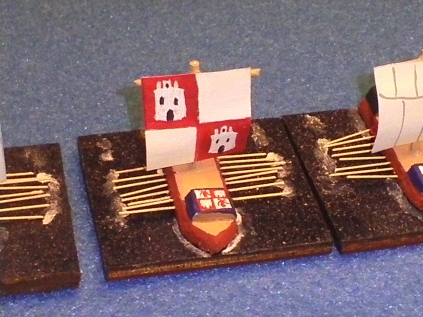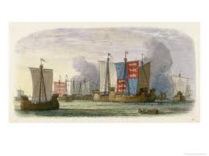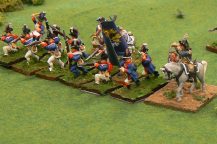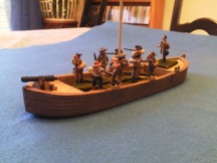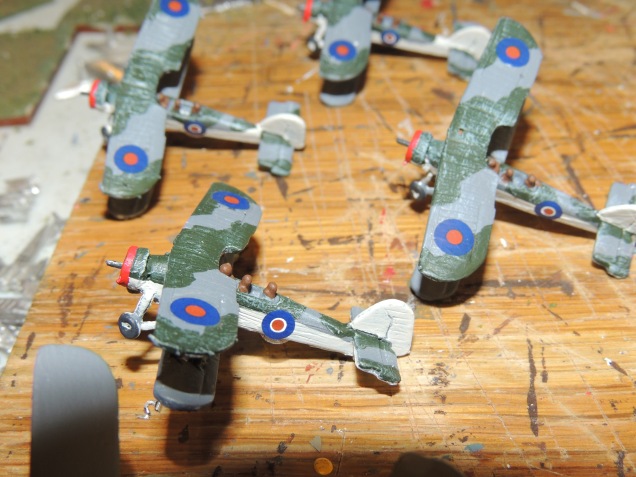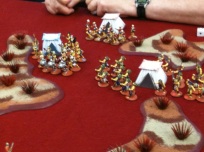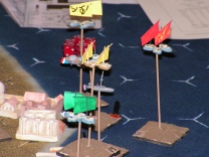As Quetzacoatl Rampant begins to wind down, I’ve already started looking at some of many unfinished projects and what to work on next. I’ve promised myself I won’t start anything new until at least next summer. My copy of The Men Who Would Be King, the next installment by Lion Rampant creator Daniel Mersey, arrived from Amazon yesterday. I’m pretty sold on the Sudan Campaigns with all the various elements from Hicks to Kitchener, maybe even Tel-el-Kebir.
Another project, probably need like a hole-in-the-head. I’ve done started lots of projects. Parted with many of them too. 15mm WWII-couple of them-gone, sold them both. 15mm ACW, gave them a good home to an old friend. 15mm WRG Ancients and Renaissance-parted with decades ago. I only have a couple of 15mm projects anymore. I have 30+ DBA armies I haven’t played with in years, plus a few unpainted for good measure. There is my 15mm Spanish Civil War army I’d like to rebase and perhaps play Osprey’s A World Aflame. I also have a bucket of 15mm fantasy figures I always intended to make into a Middle-Earth campaign built around the Battle of the Pelennor Fields.
But my heart is really set in my 28mm projects. I have more than I wish to name. All of them have importance to me, and together with various air and naval projects will be what keeps me in the hobby until I can no longer see well enough to paint.
Even so, I have some favorites that are finished or nearly so, sort of. Maybe. Here are six in no particular order:
Cogs
In 2011 I was utterly consumed by the Hundred Years War. Today I only have an unhealthy obsession. While reading and painting anything I could get my hands on, I decided I ignored the naval aspects of the conflict and needed to do something about it. After all there were the naval battles at Winchelsea and La Rochelle, and the decisive engagement at Sluys. I set out to acquire some very nice cog miniatures available from Outpost games. Unfortunately they were about 3.5 pounds apiece, and needing about 80 or more ships began to consider a better way.
I decided to build them myself. In the winter and spring of 2011 I did exactly that. I set up a cog shipyard, building nearly 100 ships. I also built a half dozen galleys and all the terrain for the scenario. British author David Manley graciously provided me with a beta copy of his medieval naval rules, and I was off to the races. It was a wonderful accomplishment. We playtested it once, ran it at Enfilade, and used the ships in a medieval naval campaign at Dave Schueler’s house for his annual naval games. Just got to get those babies out some more.
It is a completed project that was all my own work. Perhaps my proudest moment in the hobby.
Lewis and Clark and the Great Spanish-American War 1797-1810
No, there really wasn’t a Spanish American War 1797-1810. But there could have been. This project came about because I had another unhealthy obsession, the Lewis and Clark expedition from about 1997-2010. After some reading Donald Jackson’s Letters of the Lewis and Clark Expedition and running across the authorization of a Spanish force to arrest Captain Lewis and his followers, I decided there was a game in it. I tried it with mixed success at Enfilade and Drumbeat.
But the project really grew further reading about the Burr Conspiracy, the treason of General James Wilkinson, and some additional stuff about the Spanish frontier in America. The country was so close to war with Spain before and after the purchase of Louisiana Territory, why not put together some forces for a hypothetical conflict. I put together some Chickasaw allies for Spain, hundreds of militia for the Americans, and regulars for both sides. I also added some home built terrain. The crowning glory was the game based on the Burr Conspiracy I hosted at Enflade in 2013. It was simply the most interesting game I’ve ever run.
I have about 200 Indians, Spanish and Americans left to paint for this period. I should probably just get ’em done. Don’t see adding to it, though.
Any project with Daveshoe
I am blessed with some really wonderful friends. Almost all of them are gamers of one stripe or another. But our friendships go deeper than the gaming table. Dave Schueler is one of those guys. Whether we are talking games, baseball, politics or life in general, Dave is someone I want to grab a beer and hang out with.
We’ve done projects together for Enfilade at least the last ten years, and all of them have been memorable. Dave is so much better at designing games than anybody I know. If I have a harebrained idea, he can usually build a game around it that is balanced with intriguing options for both sides. He is amazing. And when I say projects together, I’m mostly the painting mule, because that’s what I’m good at-though Dave does his share and more.
The Channel Dash, the air attack on the Tripitz, a naval action in the Straits of Hormuz, hydroplane and air racing, these are some of the projects Dave and I have worked on together. My favorite, however, is the 1942 Raid on St. Nazaire we hosted at Enfilade 2014. We discussed it for years, usually over beers at the Elliott Bay Brewery in conversations that began, “Ya know, we outta . . .” The result-I became very familiar with the shade of paint known as Mountbatten Pink, and the game won best raid-themed game at the convention.
One last thing, Dave is always there to help me run games at the convention. He always knows what I’ve got going on, and helps gamers walk through my crazy schemes. He was there for the Burr Conspiracy game, a diplomacy/miniatures game which only allowed written diplomatic communications. He helped out David Sullivan and I with our Fort Pickens game last year, an attempt at a convention style Ironclads game with simplified fort rules. Both went surprisingly well, but chiefly because we had extra hands.
We haven’t discussed plans for 2017, but I’m sure we will. I think I have one more slot open. Maybe we should re-run an oldie but goody. There are so many to choose from. Nothing left to paint at the present time, except a dozen hydroplanes. But there could be . . .
Mars and the Red Captains
I don’t know how many years ago it was, maybe as many as twenty, Mark Waddington and I began talking about our unpainted collection of RAFM figures for Frank Chadwick’s Space 1889 Soldier’s Companion Rules. About ten years ago, or maybe longer, we agreed to get after it and turn it into a game. All it took was a partner to really get me going. I painted all my minis and got them ready to play. But Mark was the true evil genius. All I can do is paint, but Mark made the toys and caught the eyes not only of gamers, but of Frank Chadwick himself. Museum quality air ships, steam tanks, earth-boring vehicles all magically appeared at his finger tips like so many shiny quarters
We were hosting games at Dragonflight, ConQuest, and Enfilade and regularly attracting crowds. Games of 18 or 20 or more gamers would show up at our tables begging to play, with the two of us running games-we couldn’t swat ’em away. The game at Enfilade, however long ago, had 22 players, four GM’s and is the only non-historical game to win Best in Show.
But more than that, the Martian games really created a cottage industry of mostly South Sound gamers who wanted in on the fun. We hosted regular games supported by guys who were quietly, but rapidly amassing their own RAFM, Parroom Station. Venusians, Martians, European allies, various mechanicals, even Gene Anderson’s efforts to do the 1/1200 Sky Galleons of Mars in 28mm are all by-products of this project. All the interested parties called ourselves “The Red Captains” for those non Martians seeking fame and fortune on the Red Planet.
Though our ardor has cooled a bit over the past few years, the interest never dies. Gene’s work was the last big thing, until our efforts to put together gunboat rules for the Canals this summer. Still a project I’m proud to be a part of. Almost all of my stuff is painted. About 40 figures of flying Martians left to complete, and a unit of steam-powered mechanical horse. Less than 50 figures in all.
Hydroplanes
You almost have to be a native Northwesterner to understand my passion for this racing game. It grew out of an air racing game designed post-9/11 when we were looking for a non-lethal game to run at The Museum of Flight. It morphed into hydroplane racing while a group of us were sitting around one Sunday afternoon at Enfilade, waiting patiently for the crowds to disperse.
Dave Schueler designed the game around a simple series of choices gamers could make constructing their hydroplane and driver, and in-game choices driven by probability as the game progressed. I love running it. I love playing it. But most of all I love painting boats and promoting it to others. We’ve been fortunate to see the game played in other places, including the U.K., learned of through blog posts and other ‘net sources.
I really want to run a game at Unlimited Hydroplane Racing Museum in Kent. I’d paint pretty much any boat I can. I have twelve unpainted boats at the moment, including classic ’50’s and 60’s boats and the 70’s pickleforks.
The Hundred Years War
I’ve gone through various phases with the HYW. I am completely fascinated with the history. Every time there is a new book available I snap it up. It is interesting, it is complex, and it has constantly evolving scholarship. More than any other period, I am completely hooked.
That said, I’ve been working away on figures for this period for a decade or more. By far, I have more figures for the Hundred Years War than any other period–probably 600 painted figures, with maybe another 400 unpainted. I started with semi-skirmish, looking for rules that would allow me to do some hundreds of small actions of the period. I cobbled together a homegrown set of rules called Arrowstorm, mostly inspired by Arte Conliffe’s Tactica Medieval Siege rules. But then Lion Rampant happened, and I was completely sold on those rules with their ease of play and interesting quirky randomness.
But my real desire is to build, not only my semi-skirmish, singly mounted, armies, but armies for large scale battles. My dream is to do Poitiers, 1356. I have a fair number of multi-figure based units, but lots more are needed. I also need a set of rules I’m comfortable with that take into consideration the uniqueness of the period. Medieval combat mostly gets rolled into ancients rules that mash everything together and decide that Mauryan Indian longbows that fought against Alexander the Great at the Hydaspes and 14th Cenury English bows are the same, and had the same tactical use. I think that’s stupid and lazy. So I’ll probably end up doing something on my own. I’ve run a sample example using a Fire and Fury engine. It didn’t work well first time out of the box–another game Daveshoe helped me with. I’d like to try it again.
Literally hundreds of figures left to paint, and I can see myself acquiring more of the Perry plastics that are recently released.
There are lots more projects I didn’t write about-American Revolution, Maxmillian in Mexico, ACW Naval, air and coastal gaming. I love them all, but I’ve already blathered on too long.

Bins of stuff that needs paint



